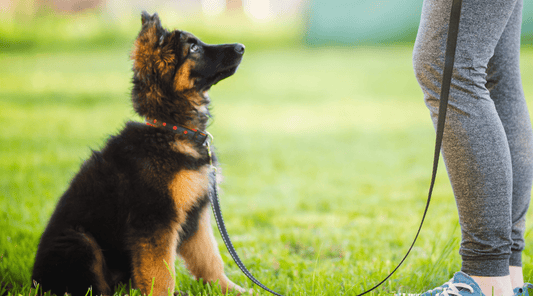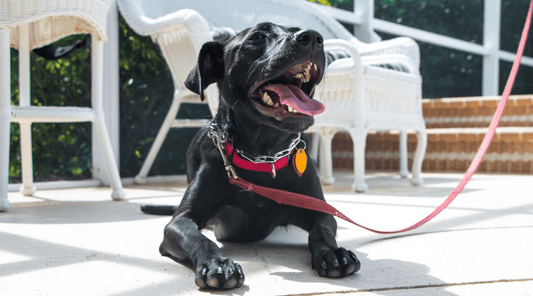How to Teach a Dog to Roll Over The Trick That Took Down My Coffee Mug
Dawn Miller May 03, 20255 Minute ReadI knew I was in trouble when I heard a loud thunk, followed by the unmistakable sound of tail thumping against hardwood.
Pixie had finally rolled over. On purpose. For a treat. And I wasn't even in the room.
Unfortunately, she’d also taken out my coffee mug in the process. The one I'd had since my kids were in grade school. Worth it? Absolutely.
Here's how to teach your dog to roll over, too—without the coffee mug casualties
Teaching Dog to Roll Over: A Surprisingly Fun Adventure
Out of all the fun dog tricks, learning how to teach a dog to roll over is easily one of the most entertaining and rewarding.
It’s the crowd-pleaser of the dog world. And honestly, many dogs don't know how to do it.
Not because they can't learn. But because this one takes a little extra patience on your part.
With some timing magic and a pocketful of high-value dog treats (the ones your dog would sell your couch for), your dog can become one of the few who know this dog trick.
Here’s how we made it happen.
Start With the Basics
Before your pup masters the roll, it needs to know how to lay down (lie down). Many people don't know this and get frustrated when their dogs don't get it.
All of those really cool dog skills you see out there, your dog can do them too!
Dogs learn commands in order until they have some pretty impressive dance moves.
If you’re still working on lay down, start there. Once they’re comfy in that position, you’re ready to roll. (Pun intended. No regrets.)
Step 1: Lure With a Treat
Get your dog to lie down on a softer surface like the lawn or carpet. You don't want to add spinal discomfort to the possible reasons they're not getting it. Once they've got it, they'll generally roll over anywhere as they figure out how to do it comfortably.
Then take a small, smelly dog treat and hold it near their nose. I say "smelly" because dogs can smell it. Their sense of smell is 10,000 times stronger than a human's. I choose beef lung bites for training. They're single-ingredient organ meat dog treats with no weird ingredients.
Now, with that dog treat in hand, slowly move it in a wide arc toward their shoulder. The goal is to get them to follow the treat with their head, which shifts their weight.
Some dogs will flop right over at this point, especially those who tend to be a little extra, like my terrier Pixie. Others, like Bruno, will look at you like you just asked them to solve a math problem.
If they just shift to one side, reward that. That’s progress. Mark it with a happy “yes!” and give a treat. Gradually build up to getting that full-body roll.
Step 2: Add the Cue
Once your dog is consistently following the treat all the way through the roll, add your cue.
Here, I just say “roll over” in a cheerful voice and make an exaggerated rolling hand motion. The verbal and visual cues together help dogs learn faster.
You can say it before or as they’re moving. But the key is consistency. Same words. Same tone. Same dramatic flourish if you’re feeling fancy.
Step 3: Keep Practice Short and Sweet
Keep sessions under 5 minutes to retain interest. Now, sometimes Pixie just wants to keep going. That's okay sometimes, but keep in mind a few things. You don't want to spoil their dinner, even if you give them all-natural, healthy dog treats.
And you need to set some boundaries with your dog so they don't think you've become an automatic treat dispenser that just keeps on giving.
Try using jazz hands when training is over. You're showing your dog that there are no more treats in your hands, so they'll move on.
In a perfect world, you'll stop while they're still excited about learning. I know that sounds like opposite day. But what this does is it creates a powerful last memory of training. So, when it's time to start again, they're eager to learn.
Plus, it's too natural to want to quit when your dog isn't getting it, creating a bad last memory. You don't want it to get to that point.
If you miss that window, go back to something they nail every single time, like "sit" or "down". Reward them like it's just the best thing ever. Then end the session.
Jazz hands.
4. Practice in Several Locations
Dogs have trouble generalizing. If you always practice in the same place, they might start thinking "the place" is part of the trick. This quirk can confuse a lot of dog parents who are thinking, he always does it perfectly at home. What gives?
To overcome this, start in a quiet place, then take your one-dog show to the park, dog park, dog-friendly coffee shop, or a neighbor's house. After 3-4 places, they'll get that "roll over" means roll over everywhere.
Dog Trick Training Tips From My Neighborhood
- Use small, high-value rewards. The tastier the treat, the more motivated your pup will be. I always use single-ingredient dog treats. What dog do you know who snubs real beef?
- Mark every step. Give tasty dog treats and praise for partial attempts. These are baby steps that will add up to a full roll, and maybe Pixie's little tail flourish at the end.
- Practice after playtime. A slightly tired dog is often more focused.
- Don’t overdo it. Rolling can be tough for older dogs or those with joint issues. Bruno needs breaks between reps.
- Consider adding a short dog bone chew session before training. When you give your dog a bone filled with bone marrow, you're letting them play with a little dog puzzle. Dog bones can increase focus and make them more eager to learn.
Make It Fun, Not Formal
Teaching dog commands isn't about absolute obedience—although positive reward training can certainly help a dog become more well-behaved.
Commands (tricks) are play to your dog. That's right! Following your commands is a form of play. As long as you keep it light and fun, they want to keep doing it.
Even practical commands like "come" and "down" are fun to them, especially if they think they might get a treat out of it sometimes.
They aren’t just doing it for food (though let’s be honest, that helps). They’re doing it because it’s a game we play together. You're bonding with your dog. They like being with you because you do fun activities together.
I didn’t just teach a trick when I taught them to roll over—I built a routine we both enjoy. That's good for dog health and great for human health too!
So grab your treats, clear a soft spot on the rug, and roll with it.
And if you’re looking for a way to start training the smart, positive way, I highly recommend jumping into the 7-Day Dog Training Challenge. You'll learn everything you need to know to build dog training routines you both enjoy.
Available On:
Disclosure: This article may contain affiliate links, which means we may earn a small commission if you make a purchase through these links—at no extra cost to you. We only recommend products we trust and believe will benefit you and your K9.






